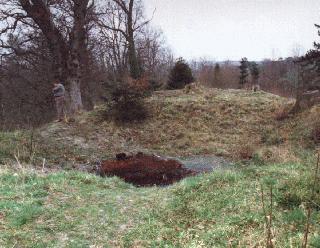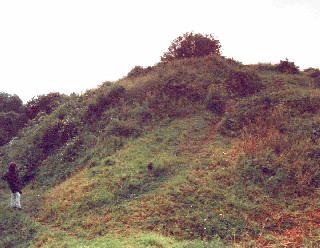The Foundation of Builth
Wells Castles
 The earthwork at Caer Beris seems to represent the first castle in the cantref
of Buellt, probably built by Philip Braose (d.bef.1138) in 1093. In 1098-1102 the archbishop
of Canterbury instructed Philip to return to the bishop of St David's those lands
he had wrongfully occupied. This almost certainly refers to his
encroachments in Buellt. The castle then seems to have remained in quiet
occupation by the Braose family for almost a century. During this time it seems
likely, judging from the pit and rubble seen on the motte-top, that the castle
was refortified in stone. In 1168 the Lord
Rhys ap Gruffydd of Deheubarth (d.1197) invaded Brycheiniog and destroyed the castle
belonging to William Braose (d.1182). From this time forth it
was out of Braose hands, although the cantref was later restored to William's
Welsh grandsons, Rhys Ieunac (d.1222) and Owain ap Gruffydd (d.1236).
However Caer Beris castle seems never to have recovered and the
cantref was henceforth ruled by Meurig ab Addaf of Buellt and, after he was
treacherously slain in his sleep in 1170, by his cousin by Maredudd Bengoch. The
power behind these two descendants of Elystan Glodrydd was almost certainly the
Lord Rhys. The position of Buellt seems to have been formalised when William
Braose Senior (d.1211) granted the province to the Lord Rhys' son Gruffydd ap Rhys (d.1201) with the hand of
his daughter Matilda some time before 1189. The province was then inherited by the two
sons of Gruffydd, Rhys Ieuanc and Owain ap Gruffydd on their father's death in
1201.
The earthwork at Caer Beris seems to represent the first castle in the cantref
of Buellt, probably built by Philip Braose (d.bef.1138) in 1093. In 1098-1102 the archbishop
of Canterbury instructed Philip to return to the bishop of St David's those lands
he had wrongfully occupied. This almost certainly refers to his
encroachments in Buellt. The castle then seems to have remained in quiet
occupation by the Braose family for almost a century. During this time it seems
likely, judging from the pit and rubble seen on the motte-top, that the castle
was refortified in stone. In 1168 the Lord
Rhys ap Gruffydd of Deheubarth (d.1197) invaded Brycheiniog and destroyed the castle
belonging to William Braose (d.1182). From this time forth it
was out of Braose hands, although the cantref was later restored to William's
Welsh grandsons, Rhys Ieunac (d.1222) and Owain ap Gruffydd (d.1236).
However Caer Beris castle seems never to have recovered and the
cantref was henceforth ruled by Meurig ab Addaf of Buellt and, after he was
treacherously slain in his sleep in 1170, by his cousin by Maredudd Bengoch. The
power behind these two descendants of Elystan Glodrydd was almost certainly the
Lord Rhys. The position of Buellt seems to have been formalised when William
Braose Senior (d.1211) granted the province to the Lord Rhys' son Gruffydd ap Rhys (d.1201) with the hand of
his daughter Matilda some time before 1189. The province was then inherited by the two
sons of Gruffydd, Rhys Ieuanc and Owain ap Gruffydd on their father's death in
1201.
An abortive foundation of the current Builth Wells castle was
probably made in 1208 by the sheriff of Gloucester. On this occasion his forces
were defeated and he was repulsed by William Braose Senior's grandsons, Rhys
Ieuanc and Owain ap Gruffydd, together with Iorwerth ab Einion Clud of Aberedw, back down
the River Wye. The sheriff returned in 1210 and completed his aborted foundation
of a new castle in Buellt. The castle was later seized from King John by the
Braose brothers in the early summer of 1215. The king sent men to aid in the
castle's further fortification in 1219, but the castle was besieged by Prince
Llywelyn ab Iorwerth (d.1240) in September 1223, until relieved soon after by royal troops. In 1229
the castle was given to Prince Llywelyn by William Braose and it was destroyed by its new princely owner soon
afterwards 'so that not one stone stood one upon the other'. On the death of Prince Llywelyn the castle site was retaken by John
Monmouth in the summer of 1240 who then began its rebuilding. The castle was
repeatedly attacked between December 1256 and its fall on 17 July 1260 when it
was again thoroughly demolished. Seventeen years later King
Edward
I ordered it rebuilt as a 'great tower' on the motte, with 'a stone wall
with six turrets surrounding the said castle (tower meant?), a 'drawbridge with
two large turrets' and stone walls enclosing the inner and outer baileys. Between
1277 and 1282 a considerable sum was spent on building this fortress, to wit £1,666
9s 5¼d. However that sum is £167 10s 6¼d less than the revenue that can be
shown to have been sent to the castle. This explains the audit demanded by the
barons of the Exchequer concerning the castle.
 Whilst
the wrangling over the missing money went on
the more mundane jobs of guarding the castle while it was built and
afterwards
were undertaken by a variety of soldiers. In 1277, nine mounted
serjeants and
forty foot soldiers protected the site, though after the surrender of
Prince Llywelyn
this figure was dropped to four horsemen and ten infantry.
Whilst
the wrangling over the missing money went on
the more mundane jobs of guarding the castle while it was built and
afterwards
were undertaken by a variety of soldiers. In 1277, nine mounted
serjeants and
forty foot soldiers protected the site, though after the surrender of
Prince Llywelyn
this figure was dropped to four horsemen and ten infantry.
In the
winter of 1294 the
besieged garrison consisted of three heavy and three light horsemen,
twenty crossbowmen and
forty archers. The force which came to relieve them, ten knights,
twenty heavy and
forty light horse made 5 sallies through the
attacking force to keep communications with the garrison open. This meant that
Builth Wells
castle avoided the fate of Cefnllys
and Morlais castles to
north and south respectively. After this Builth Wells castle tended to
become a
muster point, with troops gathering here for foreign service in 1319,
1321, 1334
and 1385. By 1402 it had become part of the command of Lord Richard
Grey of Codnor and he held it throughout the Glyndwr war. In the
Elizabethan era the
castle seems to have been dismantled after a particularly bad fire
which
destroyed much of the town. The white house beneath the castle is said
to have
been built from its ruins, as indeed much of the town of Builth Wells
seems to
be. Little now remains of this once major castle except for its
earthworks.
For more about the Braose family buy Radnor
Castle, 1066 to 1282 through the PayPal basket below.
Copyright©1994-2007
Paul Martin Remfry
 Whilst
the wrangling over the missing money went on
the more mundane jobs of guarding the castle while it was built and
afterwards
were undertaken by a variety of soldiers. In 1277, nine mounted
serjeants and
forty foot soldiers protected the site, though after the surrender of
Prince Llywelyn
this figure was dropped to four horsemen and ten infantry.
Whilst
the wrangling over the missing money went on
the more mundane jobs of guarding the castle while it was built and
afterwards
were undertaken by a variety of soldiers. In 1277, nine mounted
serjeants and
forty foot soldiers protected the site, though after the surrender of
Prince Llywelyn
this figure was dropped to four horsemen and ten infantry.  The earthwork at Caer Beris seems to represent the first castle in the cantref
of Buellt, probably built by Philip Braose (d.bef.1138) in 1093. In 1098-1102 the archbishop
of Canterbury instructed Philip to return to the bishop of St David's those lands
he had wrongfully occupied. This almost certainly refers to his
encroachments in Buellt. The castle then seems to have remained in quiet
occupation by the Braose family for almost a century. During this time it seems
likely, judging from the pit and rubble seen on the motte-top, that the castle
was refortified in stone. In 1168 the Lord
Rhys ap Gruffydd of Deheubarth (d.1197) invaded Brycheiniog and destroyed the castle
belonging to William Braose (d.1182). From this time forth it
was out of Braose hands, although the cantref was later restored to William's
Welsh grandsons, Rhys Ieunac (d.1222) and Owain ap Gruffydd (d.1236).
However Caer Beris castle seems never to have recovered and the
cantref was henceforth ruled by Meurig ab Addaf of Buellt and, after he was
treacherously slain in his sleep in 1170, by his cousin by Maredudd Bengoch. The
power behind these two descendants of Elystan Glodrydd was almost certainly the
Lord Rhys. The position of Buellt seems to have been formalised when William
Braose Senior (d.1211) granted the province to the Lord Rhys' son Gruffydd ap Rhys (d.1201) with the hand of
his daughter Matilda some time before 1189. The province was then inherited by the two
sons of Gruffydd, Rhys Ieuanc and Owain ap Gruffydd on their father's death in
1201.
The earthwork at Caer Beris seems to represent the first castle in the cantref
of Buellt, probably built by Philip Braose (d.bef.1138) in 1093. In 1098-1102 the archbishop
of Canterbury instructed Philip to return to the bishop of St David's those lands
he had wrongfully occupied. This almost certainly refers to his
encroachments in Buellt. The castle then seems to have remained in quiet
occupation by the Braose family for almost a century. During this time it seems
likely, judging from the pit and rubble seen on the motte-top, that the castle
was refortified in stone. In 1168 the Lord
Rhys ap Gruffydd of Deheubarth (d.1197) invaded Brycheiniog and destroyed the castle
belonging to William Braose (d.1182). From this time forth it
was out of Braose hands, although the cantref was later restored to William's
Welsh grandsons, Rhys Ieunac (d.1222) and Owain ap Gruffydd (d.1236).
However Caer Beris castle seems never to have recovered and the
cantref was henceforth ruled by Meurig ab Addaf of Buellt and, after he was
treacherously slain in his sleep in 1170, by his cousin by Maredudd Bengoch. The
power behind these two descendants of Elystan Glodrydd was almost certainly the
Lord Rhys. The position of Buellt seems to have been formalised when William
Braose Senior (d.1211) granted the province to the Lord Rhys' son Gruffydd ap Rhys (d.1201) with the hand of
his daughter Matilda some time before 1189. The province was then inherited by the two
sons of Gruffydd, Rhys Ieuanc and Owain ap Gruffydd on their father's death in
1201.